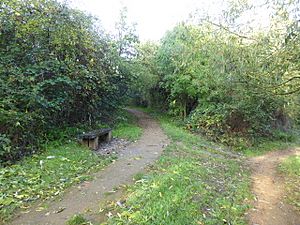Herschel Park facts for kids
Quick facts for kids Herschel Park |
|
|---|---|
 |
|
| Type | Local Nature Reserve |
| Location | Slough, Berkshire |
| OS grid | SU 977 790 |
| Area | 4.2 hectares (10 acres) |
| Managed by | Slough Borough Council |
Herschel Park is a lovely public park located in Upton, which is a part of Slough in Berkshire. The park is owned and looked after by the Slough Borough Council. It's actually made up of two connected areas. The bigger part, about 4.2-hectare (10-acre) in the north, is a special place called a Local Nature Reserve. This means it's protected for its wildlife and natural beauty. The other part, also in the north, is a more formal garden area. It's even listed as a Grade II historic park, which means it's very important because of its history and design.
Contents
Exploring Herschel Park's Landscape
Herschel Park is a beautiful green space with lots to see. It has two pretty lakes and several smaller ponds. The biggest lake even has an island in the middle, covered with tall, old trees. The park is also home to many different kinds of mature trees. Some of these are special "specimen" trees, meaning they are unique or excellent examples of their type. Others are "ornamental" trees, chosen for their beauty.
A Look Back at Herschel Park's History
Herschel Park has a long and interesting past. It has been a park since at least 1843. Back then, a man named James Bedborough bought the land. He built many houses and large villas that had great views over the park. It's thought that a famous landscape designer, Sir Joseph Paxton, helped plan the original park grounds. When it first opened, the park was known as Upton Park.
In 1949, Slough Borough Council bought the park. A few years later, in 1952, the council changed its name from Upton Park Pleasure Grounds to Herschel Park. This new name honored the famous astronomer Sir William Herschel. Later, in the early 1960s, the council bought even more land from Eton College. By 1982, this new land had also become part of Herschel Park.
Around the year 2000, something strange happened: the water in the lakes suddenly disappeared! This was a big problem for the park. So, a group called "Friends of Herschel Park" was formed. They worked with Slough Borough Council to get money to bring the park back to its original Victorian look. In January 2009, they were very happy to receive £2.7 million in funding from the Heritage Lottery Fund and the council. The restoration work was finished in 2011. The lakes were refilled with water, and the old paths were fixed up.
Because of its importance for nature, Slough Borough Council officially declared Herschel Park a Local Nature Reserve in 2013.
Animals Living in Herschel Park
Herschel Park is a home for many different animals. Here are some of the creatures you might spot:
Mammals in the Park
- European rabbit
- Eastern gray squirrel
- Reeves's muntjac (a small deer)
- Red fox
- Common pipistrelle (a type of bat)
- Field vole (a small rodent)
Insects and Other Invertebrates
- Gerridae (insects that walk on water)
- Comma butterfly
- Araneus diadematus (a common garden spider)
- Stag beetle (a large beetle)
- Six-spot burnet (a colorful moth)
- Chorthippus parallelus (a common grasshopper)
- Meadow brown (a type of butterfly)
- Libellula depressa (a broad-bodied chaser dragonfly)
Birds You Might See
- European green woodpecker
- Mandarin duck
- Mallard (a common duck)
- Canada goose
- Common blackbird
- Eurasian blue tit
- European robin
- Cetti's warbler (a small bird)
- Common kestrel (a type of falcon)
- Moorhen (a water bird)
- Egyptian goose
- Great spotted woodpecker
- Song thrush
Amphibians and Reptiles
- Common frog
- Anguis fragilis (a slow worm, which is a legless lizard)
Plants Growing in Herschel Park
The park is also rich in different types of plants and trees.
Trees in Herschel Park
- Fraxinus excelsior (European ash tree)
- Cedrus deodara (Deodar cedar)
- Aesculus hippocastanum (Horse chestnut tree)
- Taxodium distichum (Swamp cypress)
- Quercus robur (English oak)
- Quercus ilex (Holm oak)
- Lucombe oak
- Turkey oak
- Araucaria araucana (Monkey puzzle tree)
- Taxus baccata (Yew tree)
- Ilex aquifolium (Holly)
Other Plants You Can Find
- Galanthus nivalis (Snowdrop)
- Myosotis (Forget-me-not)
- Papaver rhoeas (Common poppy)
- Leucanthemum vulgare (Ox-eye daisy)
- Lotus corniculatus (Bird's-foot trefoil)
- Centaurea nigra (Common knapweed)
- Mentha aquatica (Water mint)
- Lychnis flos-cuculi (Ragged-robin)
- Caltha palustris (Marsh marigold)

